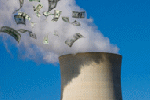The world’s beleaguered nuclear industry continues to take a battering. The “nuclear renaissance” juggernaut that once seemed unstoppable now appears dead in its tracks.
The cabinet of Germany’s conservative government on Monday voted to take the country out of nuclear permanently by 2022. Not to be outdone on the right, the country’s opposition parties say that’s not fast enough.
The conservative party in the state of Bavaria has gone even further and says that while it was first in German nuclear power, it will now be first in exiting nuclear. Bavaria, known as the “Texas of Germany” for its conservatism, gets more than 50 percent of its electricity from nuclear energy.
But it’s the sheer cost of nuclear that may overwhelm any industry “renaissance.”
Little data exists on the actual cost of new nuclear generation. Rumors persist in Ontario, Canada, that the government’s delay in building its promised new reactors was due to “sticker shock” after receiving costly proposals. Whatever the reason for delay, the actual costs of the proposals are being hidden from public view.
So policy discussions are often dependent on studies of nuclear’s cost by organizations with a particular axe to grind.
Hey, here’s some data
One exception comes from the California Energy Commission (CEC), a public agency mandated with the task of periodically examining the costs of various electricity-generation technologies that may be used in the state to meet demand. There are four operating nuclear reactors in the state, two each in two locations. There is an additional 900-megawatt reactor that was decommissioned by the Sacramento Municipal Utility District (SMUD) after a plebiscite on June 7, 1989. California is unlikely ever to build another reactor; state law prohibits construction until a permanent waste repository is available.
Nevertheless, the CEC in its most recent Integrated Energy Policy Report examined the cost of electricity from 21 different central-station generation technologies. Such studies, says the CEC, are useful for comparing the relative costs between technologies, though the actual cost of electricity to consumers can be quite different from these hypothetical studies.
The detailed study considered three forms of ownership: merchant plant, investor-owned utility, and publicly owned utility. Merchant plants are built to serve deregulated markets and assume a high degree of market risk. They may not be able to sell all their electricity at any one time if their price is too high. Investor-owned utilities are the traditional private companies serving a regulated market. In California, Pacific Gas & Electric and Southern California Edison are investor-owned. Publicly owned utilities are municipal utilities, like SMUD. Publicly owned utilities pay fewer taxes and have access to lower cost financing than either investor-owned utilities or merchant plants.
The CEC’s 186-page report, “Comparative Costs of California Central Station Electricity Generation” [PDF], found that a 1,000-megawatt pressurized water reactor would generate electricity in 2018 from as little as $0.17 per kilowatt-hour to as much as $0.34 per kilowatt-hour. These results are startling: Most renewable technologies today, even solar photovoltaics (PV), generate electricity for less than that. Only a municipal utility could generate nuclear electricity for less than the cost of solar PV.
Currently, Germany pays between $0.31 and $0.41 per kilowatt-hour for electricity from solar PV, which means that the cost of solar-generated electricity today is equivalent to the cost estimated by the CEC for a nuclear plant beginning operation in 2018. And all observers, even critics, expect the cost of solar PV to continue declining during the next decade.
And what about insurance?
In an unrelated study for the German Renewable Energy Association, consultants found that nuclear reactors are effectively uninsurable. The 157-page report [PDF] by Versicherungsforen Leipzig estimated that the premium necessary to insure a nuclear reactor from accident would cost from $0.20 per kilowatt-hour to a staggering $3.40 per kilowatt-hour.
Thus, the cost to insure a nuclear reactor — at a minimum — would cost as much as the electricity itself from a nuclear plant coming online in California in 2018.
Earlier German studies of the cost for insuring reactors against catastrophic failure found similar results. A 1999 report for the European Commission on the externalities of energy found that the external cost of nuclear power was $2.59 per kilowatt-hour largely due to the cost of insurance.
These studies indicate that the cost of nuclear energy is far higher than proponents have led policymakers to believe.
Renewable energy, even costly solar photovoltaics, begins to look like a bargain to consumers when realistic costs of new nuclear plants come to light.


